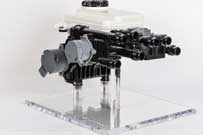BEV makers need to find ways to improve the efficiency of their vehicles to increase their range and reduce charging time. Recently, major European OEM challenged Hutchinson to design an integrated module to manage cooling in BEVs, with the goal of increasing the overall efficiency of the vehicle.
By integrating the pump, valve, expansion tank, and the manifold, it could create a system that used less power, less space, lost less pressure, improved range, and reduced charging times.
The thermal management systems provider says it drew on its expertise in valves, internal sealing, plastic injection, and thermal management, and proposed an integrated design that used multi-way valves to reduce power consumption and internal gaskets specifically designed to achieve the challenging specifications of the customer.
Hutchinson says it worked at its internal simulation and testing facilities to evaluate different designs and their impact on the energy efficiency and range of the vehicle, to create a solution that offered the optimum combination of size, weight, efficiency, and power consumption, and validate it in-house to ensure the performance and durability of the solution.
The integrated cooling module used fewer parts, decreasing the number of connections in the system and reducing the chance of leakage. It also cuts down the overall volume of the cooling system, so it required less space, and it was also lighter, helping to extend the range of the vehicle.
Most importantly, it offered improved performance and efficiency, using less power to run the cooling loop and therefore drawing less energy from the vehicle’s battery. This also extended the vehicle’s range and decreased charging time. The customer was able to review the efficiency of different approaches at Hutchinson’s testing and simulation facilities, enabling them to select the solution that worked best for them.
In tests, Hutchinson says its integrated cooling module delivered marked improvements in both vehicle range and charging times: in cold conditions, the system was found to improve range by 8% and charging time was improved by 12%, thereby translating to better performance for OEMs and less range anxiety for end consumers.

